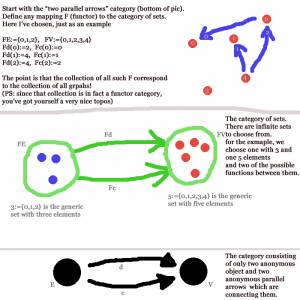Functor category
Collection
| context | ${\bf C}$ … small category |
| context | ${\bf D}$ … category |
| definiendum | ${\bf D}^{\bf C}$ in $\mathrm{it}$ |
| definition | $\mathrm{Ob}_{{\bf D}^{\bf C}}:={\bf C}\longrightarrow{\bf D} $ |
| definition | ${\bf D}^{\bf C}[F,G]:=F\xrightarrow{\bullet}G$ |
Discussion
Firstly, A class of sets together with functions between them form a category. The only job of the arrows between objects here is to transfer individual elements from set to sets. Secondly, A class of categories and functors between them is a category too, but here the objects exhibit some internal structure and the arrows are required to respect that structure. Finally, A class of functors and natural transformations between them also form a category, call it ${\bf D}^{\bf C}$. Here, the objects can be thought of as copies of the category fixed category ${\bf C}$ seated inside of ${\bf D}$, and the arrows must respect (only) the ${\bf C}$-structure.
Some very simple examples
If ${\bf 5}$ is the discrete category of five different objects, then ${\bf Set}^{\bf 5}$ is the category of all choices of up to 5 sets. ${\bf Set}^{\bf 1}$ is just ${\bf Set}$ itself. If we'd consider a category ${\bf 5}'$ to be the same category with some ordering of the object expressed arrows, then ${\bf Set}^{{\bf 5}'}$ is just the category of all choices of up to 5 sets, where the arrows expressing ordering are substituted by some function.
Again, a functor $F:{\bf C}\longrightarrow{\bf D}$ just embeds the diagram ${\bf C}$ within a category ${\bf D}$. Therefore, think of the functor category ${\bf D}^{\bf C}$ as the collection of all (possibly squeezed) copies of ${\bf C}$ in ${\bf D}$.
Algebraic picture if the target is structured
The nice target category ${\bf{Set}}$ is like a ring (say $\mathbb R$) and the functor category ${\bf{Set}}^{\bf{C}}$ with objects $\omega,\mu,\dots$ is like a space of functionals on a space ${\bf{C}}$. The topos/functional space is richer than the base ${\bf{C}}$: The target (${\bf{Set}}$ resp. $\mathbb C$) has a nice algebraic structure (e.g. co-products resp. addition), which we can pull back to define one on ${\bf{Set}}^{\bf{C}}$. As in $\omega+\lambda:=\left(v\mapsto\omega(v)+\mu(v)\right)$.
Adding more details leads to finer analogies: If $\mathbb C$ has co-products itself, then it's like a vector space and it's object should be viewed as a set of base vectors. If a functor preserves co-product, it's like a linear functional and ${\bf{Set}}^{\bf{C}}$ becomes a kind of dual vector space. This sheds light on the (co-variant) Yoneda embedding: If we view the objects of $\mathbb C$ as a set of base vectors, then the can be mapped to functionals in the dual space, but that space is bigger / also contains a lot of other functionals.
Remark: We don't necessarily need to take ${\bf{Set}}$ as target, although it's the traditional choice. It corresponds to the cardinal arithmetic (arbitrary cardinals). Meanwhile, the category of finite sets behaves like natural number (finite cardinals) and groupoids behave like reals (groupoid cardinality can be defined, where non-trivial automorphisms give fractional cardinality).
Example
Reference
Wikipedia: Functor category
